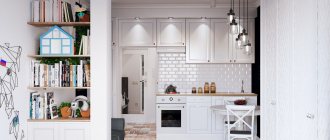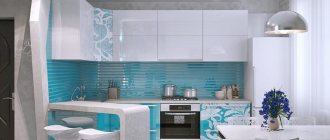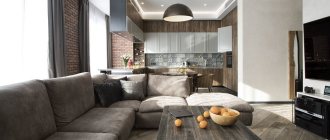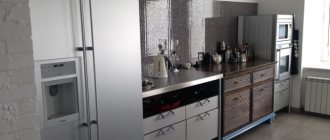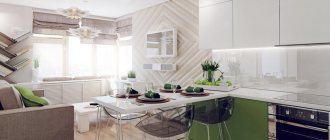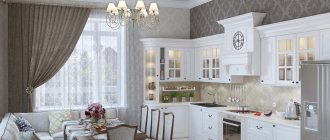Zoning the kitchen and living room can be done in the simplest way: build a real plasterboard wall between them. But this option lacks elegance, and besides, it deprives the opportunity to make the design interesting, to introduce an element of spaciousness into it.
Kitchen with island on podium
If we are talking about two rooms, then partitioning without a wall allows you to turn a cramped small kitchen into a work area, and the living room into a dining room, without the need to look for space for these corners in the kitchen.
Glass partition between living room and kitchen
If the kitchen space is large enough, proper zoning will allow you to receive many guests, everyone will be comfortable and conveniently located. And in a one-room studio you can’t do without division.
Kitchen set between dining room and living room
Fencing off the kitchen from the living room
Usually the simplest solution is considered optimal: a work area is created in the kitchen, the floor of which is lined with materials that are resistant to temperature changes, humidity and pollution. And in the living room there is a dining area: they put a table and chairs, make sure that the interior looks beautiful and stylish.
Floor in kitchen and living room zoning
At the same time, zoning presupposes that space needs to be allocated, accents should be placed correctly, and care should be taken about colors and lighting. There are many ways to divide a room into two zones, a kitchen and a living room, and not all of them are as simple as the idea of separating the area with a partition.
Studio kitchen design: where to start?
If you have been living in a house with an old, uncomfortable layout for a long time and are eager to change something, go for it! The first thing you need to do is find out from the relevant authorities whether it is possible to remove the wall between the kitchen and living room. When such issues are agreed upon, transformation can begin.
Think carefully about the design of your studio kitchen. There are many options for combining a kitchen, living room, and dining room. In the future, you will get one common space that will be spacious and bright.
You think you can remove the walls - and voila, the design is ready! No, it's not that simple. It is important to plan the placement of furniture so that it is intuitively clear where one functional area ends and another begins. At this stage it is worth paying attention to all the little things. The price of a mistake can cost you feelings of insecurity and discomfort.
But let's not talk about sad things. Let's better talk about the rules. Follow the recommendations of Dekorin designers, and you will succeed!
Partition
A simple and obvious zoning option
For owners of a large, well-lit room, it is best to zone the room with a partition. It is important to understand that this method cannot be used in a studio (due to the small area).
Zoning the living room and kitchen with a black partition
The following can act as a protective element:
- plasterboard walls are thin, with poor sound insulation and the inability to drive a nail in without cracking the wall;
- glass screens are an original method, and in most apartments they are made not from transparent glass, but from smoky, frosted, with rectangular cells, colored (otherwise the separation will not be obvious);
- furniture - you can put a real chest of drawers, but this is not interesting, so they usually place shelves and shelves, which are used on both sides.
Kitchen-living room with partition
Interestingly, the partition does not have to be continuous and all the way to the ceiling. One neat way to divide the space is to install a wall with a window so that the kitchen side makes it easy to serve food into the living room.
Kitchen-living room with island
Bar counter
The bar counter fits perfectly into the loft, but it would also be out of place in the English classic style
With its help, you can delimit space not only in modern styles (although for a loft it is, of course, a calling card), but also in classic ones. The advantage is that the bar counter is not only an element needed for zoning, but also a useful part of the kitchen set. You can cook on it - it’s convenient because it’s high and you don’t have to bend over. It is recommended to store dishes and tools under it - there is a special compartment for them. A chrome pipe can be attached from the ceiling to the stand, on which tools are placed.
Kitchen-dining room with bar counter
And, of course, it’s convenient to just eat at it, especially if one person needs a quick snack rather than dinner for the whole family.
Interestingly, this element can be combined with selection using a partition. In this case, it is made of brick or plasterboard; an opening is made in it, onto which the rack cover is attached. Swivel chairs are placed on both sides.
Zoning the living room and kitchen in high-tech style
Separation with curtains
Curtains can look like a reference to traditional zoning methods or be a great addition to a modern style
The next idea is also good: hang the curtain so that it separates the zones from each other. The advantage of this solution is mobility. A closed curtain looks like a partition and completely separates the kitchen from the living room. But as soon as you open it, the division disappears and you get one room again. This distinction looks good in oriental classical styles, for which it is traditional.
But in other cases it can look quite good.
Decorative partition between the kitchen and living room
Equipment for a studio kitchen in a new building
If you purchased an apartment without a layout, then an excellent solution would be to equip a kitchen combined with a living room. You can order a project designed specifically for your family.
This solution will allow you to get the following advantages:
- Get a unique design for your kitchen and living room.
- You can become the owner of a luxurious room.
- Your kitchen will be initially designed according to an individual project.
- You can create a sophisticated design in your living room.
- A professional designer will choose the right combination of colors.
By entrusting the design development to specialists, you will receive a unique studio kitchen
You can divide the space into several zones using the most modern methods.
Equipping a combined kitchen in a new building will allow you to initially carry out a design intended for many years of use.
Podium
The podium should be combined with other methods of zoning or at least properly lit
Different floor levels are also a great way to visually separate zones from each other. Most often the kitchen is made higher. The height difference is usually small - no more than 20 cm - to avoid falling. To make it easier to overcome, steps are built, most often of a decorative shape - semicircular, etc.
Kitchen layout options
What to consider when remodeling a kitchen in a studio apartment
It should be taken into account that a studio kitchen would look most appropriate either in a large apartment with at least three rooms, so that each family member still has a private, closed space, or, conversely, in a small one. In the latter case, it will even be possible to enlarge the apartment by removing interfering walls and facilitating access to every corner of the home. Studio apartments are especially loved by men who are too lazy to go around all sorts of obstacles every time trying to get from their vacation spot to the refrigerator.
When decorating a kitchen in a studio apartment, you definitely need to approach it wisely and with careful preparation. The most important thing is to prevent clutter and wasteful use of space. To begin with, decide what you yourself want to see in your kitchen studio, what you plan to do there, where it is convenient for you to place a washing machine, microwave oven, TV, sofa, etc. If you are not going to invite guests often, then you should not buy a large table.
Read: Kitchen design 9 sq. m. - 55 photos in the interior
If you like to cook and watch TV at the same time, then position the table so that you can see the screen from your workplace.
There are several tricks that will allow you to choose the design of your studio kitchen so that every centimeter of space is used as efficiently as possible, while creating the perfect picture. Examples can be seen in the photo of the studio kitchen.
Zoning with an arch
You can hang a light curtain made of beads in the arch - this is a beautiful reference to southern styles
This method is used if we are initially talking about two rooms. Separating them from each other with an arch instead of a door is easier than completely demolishing the wall. Combines perfectly with other zoning methods: lighting, podium, curtain. The arch itself looks rather poor and needs additional contrast to make the division into zones obvious.
Zoning the living room and small kitchen
Sliding walls and mobile modules
Sliding walls are common in offices, but they can also look good in a residential building.
Sliding walls are commonly used in offices and are associated with them. The glass elements are high (to the ceiling), easily transmit light and move from place to place. They are built into special grooves, and the useful area, unlike most other methods, is not hidden at all.
White and brown kitchen-dining room
They help to instantly change the layout of the room: here there were two rooms separated by a glass wall, but the partition was pulled back - a single space was created.
Zoning the living room and kitchen in country style
Glass is used in different ways (depending on customer requests). It can be matte, transparent, colored, engraved, patterned, or even stained glass. To better imagine the effect, you should first look at photographs of rooms where different types of glass were used.
Original layout of the kitchen-living room
Zoning the kitchen-living room using an arch
Zoning using visual techniques
Different style, color and finishing materials - and now the zones are already separated from each other without additional elements
The role of stylistic decisions in zoning cannot be underestimated. They greatly influence perception. If the budget is limited, then you can get by exclusively with them.
Spacious kitchen-living room with cabinets
So, different areas require different materials. For the worker - those who will not suffer if hot soup from a pan spills on them. This:
- tiles are resistant to everything except mechanical damage, they look beautiful if you choose the right pattern;
- natural stone is very strong, the only drawback is its heaviness, you will have to consider whether such floor tiles will withstand it;
- linoleum is afraid of heat, wears out quickly, but it will serve its 5-7 years honestly, and then you can replace it with something of a higher class;
- laminate - also does not tolerate temperature changes, but with careful handling it lasts a long time.
Zoning the living room and kitchen in a private house
Zoning the kitchen and living room with an aquarium
The walls in the work area are tiled or partitions are painted, plastered or finished to look like brickwork. Wooden panels, fabric or wallpaper cannot be hung - they are afraid of high temperature and humidity.
Plasterboard wall between living room and kitchen
Zoning the kitchen and living room with doors
The materials in the dining area should be different. Parquet is permitted - despite its instability, it can last for many years far from the stove. Or you can use carpet - it gets dirty easily, but is soft and looks nice. Wallpaper (including photo), plastic or wooden panels (made of chipboard) are attached to the walls.
Zoning the living room and kitchen with a bar counter
Kitchen-living room with dining table
In addition to different materials, colors will help to clearly divide zones. There is no clear division between those that are suitable for a dining or kitchen space. They just have to be different. Here are approximate options:
- the same color, different shades - it looks a bit boring, but it’s great for classic styles;
- contrasting ones are a good solution for modern styles that require tension and drive;
- the same shade, different accents - for example, white, which is complemented by narrow yellow stripes in the kitchen area, and wide orange stripes in the dining area.
Zoning the kitchen-living room using a podium
Arched opening between living room and kitchen
The style can be either the same or different, but, nevertheless, it must be combined with each other. You should not combine modern trends with classical ones. It is important to think through in advance how everything will look (not in your head, but either on paper or using a computer).
Wardrobe between living room and kitchen
Kitchen-living room with island
Design of a studio kitchen combined with a living room: placing light accents
You can achieve a visual division of different zones in a kitchen-studio combined with a living room using thoughtful lighting. This is especially true for the design of small rooms. Despite the limited area, the living space should be well lit.
In the recreation area, where the sofa and dining table are located, a chandelier is usually used. It can be the starting point of the entire design or its logical conclusion. Identical lamps located above the kitchen look original. Just like in these photos.
The different functional purposes of individual segments of the studio can be emphasized by framing the corresponding area on the ceiling. It could be:
- plasterboard box;
- tension covering of a different texture;
- spotlights located in a special way.
In the kitchen area, it is imperative to illuminate the work and hob surfaces. An interesting effect can be achieved with LED lighting running along the bottom of the kitchen unit. This will make the design more stylish.
Want to learn more about zoning in a studio? The designers of the Decorin project recommend that you read this article.
Your kitchen-studio with living room does not have to be an exact copy of one of the photographs. Take your favorite idea as a basis. And make the interior individual, comfortable for you.
Proper zoning using lighting
The right light is half the battle
The last thing that can play a role in visual perception is lighting, which can completely change the appearance of a room.
Zoning the kitchen and living room in a rustic style
Screen in the zoning of the living room and kitchen
Firstly, it should not be homogeneous. It’s worth forever forgetting about the lonely light bulb under the ceiling, even if the apartment is a Khrushchev-era building and far from the center.
Zoning the kitchen-living room using a bar counter
Zoning the living room and kitchen with a fireplace
Secondly, with the help of lighting devices you need to emphasize the differences that exist between zones. Flashlights highlight important elements.
Zoning the living room and kitchen in retro style
Zoning the living room and kitchen with white columns
Typically the arrangement of lamps looks like this:
- in the work area. The one who cooks needs to cut, mix, cook and make sure that the pieces of vegetables are the same size, you need to put a bright light on the wall, above the work surface. It could be a sconce or an LED strip, it doesn’t matter. The main thing is the accent;
- in the dining area. Usually this is a lamp above or on the table. It should match the interior, the light should be yellow, warm and pleasant to the eye;
- overhead lighting of the work area. It is advisable that it be tied to a separate switch.
- accents. Is there a TV in the room? It can be placed on a shelf with lighting. If there is a beautiful picture, then it is better to highlight it. Is there a chair in the corner? Then it needs a floor lamp. And on holidays, you need to attach a garland to the window or glass door of the balcony.
Plasterboard wall between living room and kitchen
Zoning the living room and kitchen with colored walls
The lighting of each group must operate separately from the others. This method helps make it more flexible and solve a wider range of problems. Otherwise, the style of the lamps and their color depends on the direction in which the rest of the room is designed.
Kitchen-living room with peninsula
Shelves and stairs in the living room and kitchen zoning
Zoning space in a kitchen studio
Of course, the entire kitchen-studio room should look like a single whole, with a harmonious, functional and comfortable interior. But at the same time, it would be useful to outline boundaries (most often conditional) for all functional segments, so the studio space will acquire orderliness and even some rigor in design. Let’s look in more detail at what interior elements and design techniques can be used to zone an open-plan room.
Combining finishes of different surfaces
A studio kitchen should be presented in a single image, and the same finish in all functional segments of the room is incredibly helpful in this regard. But, you must admit that not every method of surface design is suitable for such a functionally loaded and specific area as the kitchen. While the finishing of the ceiling and walls in the dining area may well be the same as in the living room sector (a powerful hood will help prevent particles of burning and grease from settling on surfaces), then with the flooring, not everything is so simple. The best option for finishing floors in the kitchen work area is ceramic tiles. It can be effectively combined with the flooring of the living room area, made of laminate, parquet and even carpet.
It is also inevitable that there will be a difference in the finishing materials used on the walls of the studio kitchen and the apron, as the area most exposed to moisture, high temperatures and various contaminants. But the design of a kitchen apron cannot be called a zoning element, rather a way of creating a practical accent.
Multi-level ceiling and floor
By creating a low podium for the kitchen and dining area, you can unobtrusively separate the lounge segment of the living room, while maintaining the feeling of spaciousness of the common room. In such a structure you can hide all communications, install a heated floor system, and install lighting. A similar technique can be achieved by constructing suspended ceilings of different levels. For example, the kitchen and dining area may have a lower ceiling level with recessed lights located around the perimeter or in areas of greatest need. And in the living room it will be enough to hang a chandelier and install a floor or table lamp.
Zoning with furniture
One of the most popular, logical and practical ways to create a conditional division of a room into functional segments is zoning using furniture items. A bar counter, peninsula or island can help create some border between the kitchen area and the living room. Also, a dining group - a table with chairs - can easily cope with this role. At the same time, the functionality of a kitchen island or peninsula can be addressed to both zones - on the kitchen side, conventional storage systems can be located behind solid facades; on the living room side, a display case with glass doors and spectacular lighting can be installed.
If we talk about visually highlighting the living room segment, then most often the border is delineated with the help of a large sofa - regular or corner. In this case, it is the corner sofa that allows you to create a kind of relaxation sector, enclosed by its rear walls.
Interior partitions, shelving or false walls to partially divide the space
Of course, the use of interior partitions (in any of their modifications) somewhat disrupts the openness of the kitchen-studio layout. But sometimes such elements are simply necessary to maintain the integrity of the character of the room and some highlighting of certain residential segments. In spacious studios, such a design technique will hardly disrupt the movement of light and air, or traffic between functional areas. In modern interiors, glass partitions are often used - they almost do not interfere with the spread of light, allow you to see what is happening in the neighboring area, but block the path of cooking odors from spreading.
Lighting fixtures as a zoning element
In a spacious room combining several functional areas, you simply cannot get by with a single central chandelier. Using local light sources or strip lighting, you can create a unique lighting scenario in each segment of the studio space. It is necessary to create a high level of illumination in the kitchen work area, which will allow all kitchen processes to be carried out with a high level of safety. In the living room area, soft, diffused light created by pendant, wall or floor lamps is more suitable (it all depends on the overall concept of the interior and your personal preferences).
Whatever zoning method you choose (and most often several options are woven into a single picture of a studio interior), it is important to preserve the general character of the space design. Designers recommend using light, neutral colors to decorate such rooms. A calm palette that does not irritate anyone with its brightness or variegation will help create a peaceful atmosphere both in the entire room as a whole and in each functional segment in particular. Bright accents - textiles, dishes, decorative elements - will help to revive the interior of a kitchen studio. Such interior items are easy to replace if the color accent is boring or seems uninteresting to you.

